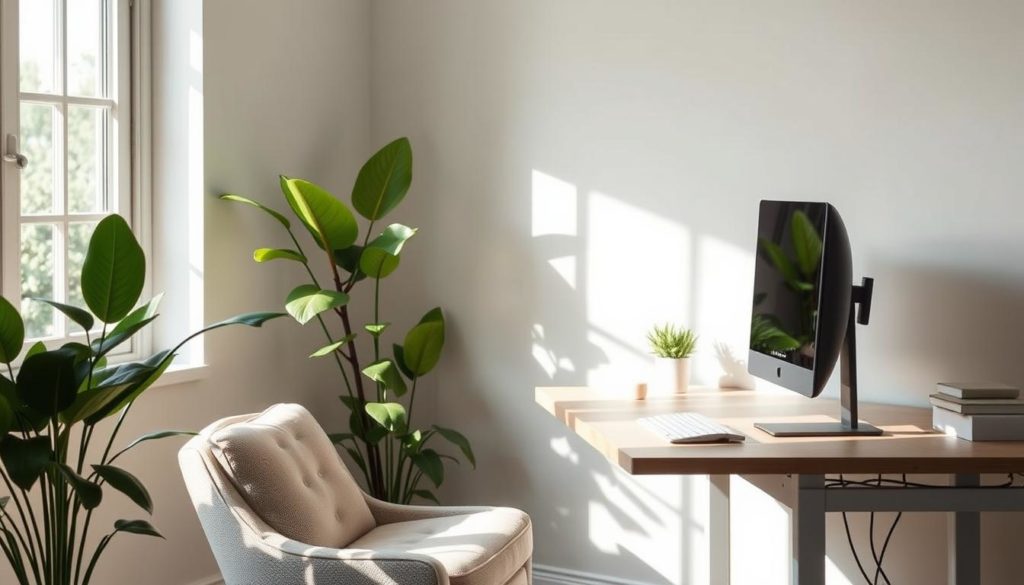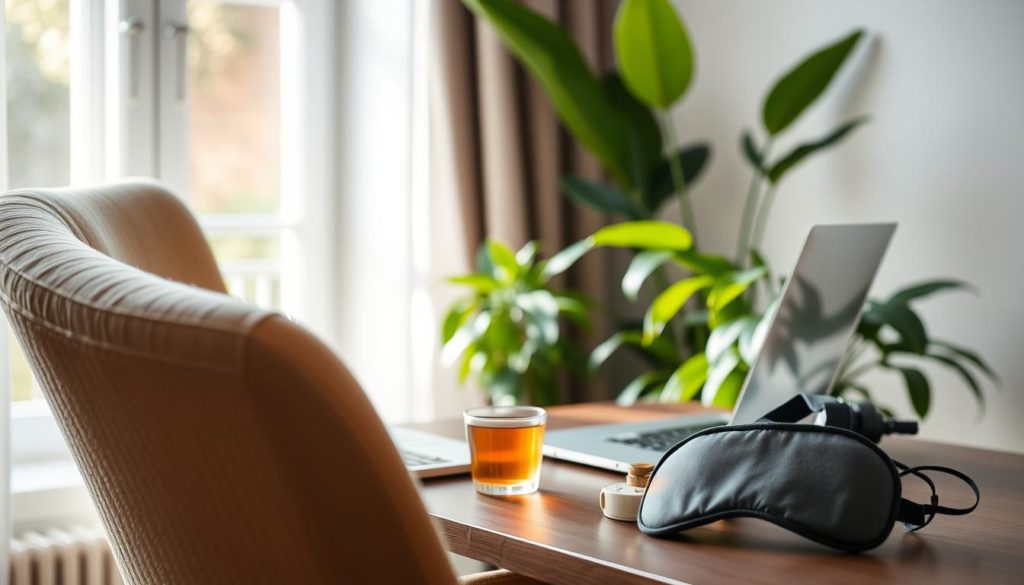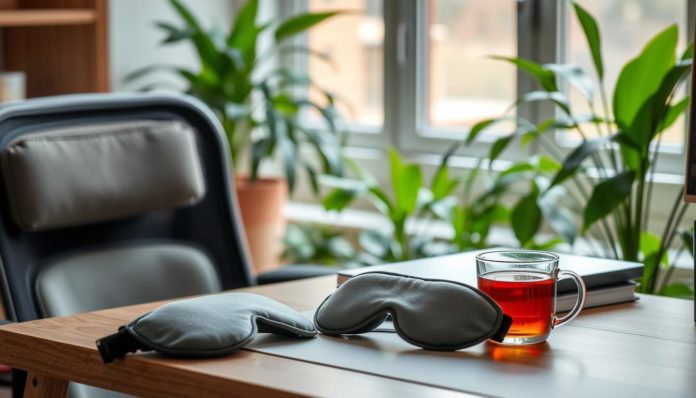Did you know over 60% of Americans get eye fatigue from screens? Our world is full of screens, making eye fatigue common. If you often feel tired eyes after work, you’re not alone. There are easy ways to feel better.
Our eyes aren’t made for all the screen time we do today. This guide offers tips to prevent eye fatigue. It helps keep your eyes healthy and makes screen time more comfortable.
We’ll look at why eye fatigue happens and how to stop it. We’ll share eye health tips to help you avoid eye strain. Let’s make eye fatigue a thing of the past!
Understanding Eye Fatigue
Eye fatigue, also known as asthenopia, is a common issue many face. But what causes eye fatigue exactly? It comes from overworked eyes, often due to long computer use, bad lighting, or eye problems.

Looking at screens for too long can cause digital eye strain. This can hurt your productivity and quality of life. If not treated, it can make your eyes sore, dry, and tired. It’s key to spot these signs early to avoid eye strain and keep your eyes healthy.
Here are the main reasons for eye fatigue:
- Extended screen time without breaks
- Poor lighting conditions
- Undiagnosed eye problems
By managing these factors, you can lessen eye strain and avoid more problems. Stay tuned for more tips on fighting and easing eye fatigue.
Importance of Regular Breaks
Taking regular breaks is key for eye strain prevention, especially for those who stare at screens a lot. It’s important to give your eyes a break to avoid eye strain and boost your work efficiency.

20-20-20 Rule
The 20-20-20 rule is a simple way to take breaks. Every 20 minutes, look away from your screen for 20 seconds at something 20 feet away. This helps your eyes relax and refocus, reducing eye fatigue.
Stretching and Moving
Besides eye breaks, don’t forget to stretch and move around. Stand up, stretch your arms and legs, and take short walks. This helps with eye strain and keeps your body healthy by improving blood flow and reducing muscle tightness. Making these habits part of your day can help you avoid eye strain effectively.
Proper Lighting Conditions
Setting up the right lighting is key to avoiding eye strain from computers. It’s not just about how bright it is. The quality and direction of the light matter too. Let’s dive into the important details.
Avoiding Glare
One important tip is to steer clear of glare from your screen. Glare can cause eye discomfort and tiredness. Move your monitor away from windows and direct lights to cut down on reflections and harsh contrasts.
This small change can make a big difference in your comfort and work efficiency.
Using the Right Bulbs
Choosing the right bulbs is also crucial for eye health. Opt for bulbs that mimic natural daylight. They help reduce eye strain and offer a balanced color spectrum that’s easier on the eyes.
By following these tips, you can enjoy a more comfortable viewing experience. It also helps prevent eye strain from computers.
Choosing the Right Monitor Settings
Keeping your eyes healthy while using computers starts with the right monitor settings. Adjusting these settings can greatly reduce eye strain.
To prevent eye strain, you need to tweak a few display settings. Here’s a simple guide to make your monitor more eye-friendly:
- Brightness: Make sure your monitor’s brightness matches your room’s light. Too bright or too dark can cause eye fatigue. Adjust the brightness to a comfortable level.
- Contrast: High contrast makes text easier to read, which helps prevent eye strain. Find a balance where whites are clear but not too harsh.
- Color Temperature: Use a warmer color temperature, especially in dim light. This reduces blue light exposure and helps prevent eye strain.
“Minimizing blue light and keeping your monitor’s display settings optimized for long-term use can make a notable difference in eye comfort.”
Here’s a table comparing different monitor settings:
| Setting | Description | Recommendation |
|---|---|---|
| Brightness | Measures the light intensity of the monitor display. | Adjust to match room lighting. |
| Contrast | Difference between light and dark on the screen. | High for clear text and images. |
| Color Temperature | Warmth or coolness of the monitor’s color display. | Warmer tones for night use. |
By fine-tuning these settings, you can make your screen more comfortable to look at. This helps prevent eye strain and improves your overall well-being when using computers for a long time.
Maintaining Optimal Screen Distance
To avoid eye strain, it’s key to keep the right distance from your screen. The right screen placement is vital for comfort and less eye fatigue.
The best distance is about an arm’s length, or 20 to 30 inches. This reduces eye strain by cutting down on focusing effort. Place the screen’s center at eye level or a bit below.
Ergonomic tips for computer use are not just about comfort but also about boosting productivity while safeguarding your eye health.
Also, tilt the screen a bit to cut down glare. Make sure the top of the screen isn’t above your eyes. This keeps your neck, shoulders, and back in a natural position.
To use ergonomic tips well, remember these points:
- Keep the screen at eye level or just below.
- Position the screen about 20 to 30 inches away from your eyes.
- Ensure that the screen is tilted slightly backward.
- Maintain an upright posture to support overall spinal health.
By following these tips, you make your workspace better for your eyes and body. This shows how to prevent eye strain well.
| Screen Position | Benefits |
|---|---|
| 20-30 inches away | Reduces strain on the eyes and allows for comfortable viewing |
| Eye level or slightly below | Ensures a natural and comfortable head position |
| Tilted backward slightly | Minimizes glare and promotes ergonomic posture |
Using these ergonomic tips can make your daily screen time better. It ensures the right screen placement and distance. These steps help make a healthy workspace and show how to prevent eye strain.
Using Eye Drops and Hydration
Keeping your eyes hydrated is key, especially if you’re on screens a lot. Artificial tears are a great way to prevent eye fatigue. They help keep your eyes moist and reduce irritation.
Drinking enough water is also important. It helps your body keep your eyes moist. This is why staying hydrated is so crucial for your eyes.
Here are some easy ways to keep your eyes hydrated:
- Use artificial tears regularly if you experience dryness.
- Take breaks when you’re on screens for a long time.
- Drink at least 8 glasses of water a day.
| Tips | Benefits |
|---|---|
| Regular use of artificial tears | Lubricates eyes and reduces dryness |
| Stay hydrated | Maintains natural eye moisture |
| Frequent breaks from screens | Prevents eye strain and fatigue |
By following these tips, you can make your eyes more comfortable. Remember, hydration is key. Use artificial tears and drink plenty of water to keep your eyes healthy.
Tips to Prevent Eye Fatigue
Technology is a big part of our lives now. It’s important to take care of our eyes. By following some simple tips, we can avoid eye strain and keep our eyes healthy.
Start by making your workspace better for your eyes. Place your computer screen far enough away so your arms can rest on your desk. Also, adjust the brightness and contrast to make it easy on your eyes.
Healthy habits are key. Try the 20-20-20 rule: every 20 minutes, look at something 20 feet away for 20 seconds. This easy tip helps a lot in avoiding eye strain.
Don’t forget to blink often. Blinking keeps your eyes moist and stops dry eyes. Also, good lighting is important for your eyes.
To understand these tips better, here’s a simple table:
| Practice | Benefit |
|---|---|
| 20-20-20 Rule | Reduces Eye Strain |
| Proper Screen Distance | Decreases Fatigue |
| Frequent Blinking | Prevents Dry Eyes |
| Appropriate Lighting | Minimizes Glare |
By adding these eye health tips and daily practices to reduce eye strain to your routine, you can greatly improve your eye health and comfort.
Importance of Regular Eye Exams
Regular eye exams are key for more than just seeing clearly. They help keep your eyes healthy. By following these eye care tips, you can spot problems early and stay comfortable.
Detecting Vision Problems Early
One big benefit of regular eye check-ups is finding vision issues early. This could be a need for new glasses or a hidden problem. Catching these early can stop eye strain and keep you feeling good.
Customizing Prescription Lenses
Eye exams also mean getting lenses that fit you perfectly. It’s not just about seeing well; it’s about feeling good too. The right eyewear adjustments make a big difference in comfort.
Here’s a quick look at the benefits of regular eye exams:
| Benefits | Details |
|---|---|
| Early Detection | Identifies vision problems before they escalate. |
| Tailored Lenses | Custom prescriptions for maximum comfort. |
| Prevent Strain | Reduces eye fatigue with accurate eyewear adjustments. |
Blue Light Blocking Solutions
Blue light from screens can cause eye fatigue. With more screen time, finding ways to reduce this strain is key. Blue light blocking glasses and screen filters help protect your eyes from glare and promote better eye health.
Using Blue Light Glasses
Blue light glasses are a simple way to fight eye strain. They filter out harmful blue light from screens, easing eye fatigue. Wearing these glasses can improve sleep, reduce headaches, and make your eyes feel more comfortable.
By wearing blue light glasses daily, you can greatly reduce the harm of too much screen time.
Screen Filters
Screen filters are another great way to shield your eyes from glare. They can be placed on your monitor or mobile devices to block blue light. If you don’t like wearing glasses all the time, screen filters are a good alternative.
They also offer privacy by making it harder for others to see your screen from the side. This makes them useful for both eye health and privacy.
Using blue light glasses or screen filters can make your screen time more comfortable. It helps ensure that hours in front of screens won’t harm your vision or overall health.
FAQ
What causes eye fatigue?
Eye fatigue, also known as asthenopia, is often caused by too much computer use. It can also come from bad lighting or undiagnosed eye problems. Looking at screens for a long time can make your eyes feel strained and uncomfortable.
How can I prevent computer eye strain?
To avoid eye strain from computers, follow the 20-20-20 rule. Every 20 minutes, look at something 20 feet away for 20 seconds. Also, adjust your monitor settings, make sure the lighting is right, and keep your workspace ergonomic.
What is the 20-20-20 rule?
The 20-20-20 rule is a simple way to care for your eyes. It says to take a 20-second break every 20 minutes by looking at something 20 feet away. This helps reduce eye strain and gives your eyes a break.
How can proper lighting help reduce eye strain?
Good lighting reduces eye strain by cutting down on glare and providing enough light. Place your lights to avoid reflections and use bulbs that make your space comfortable to look at.
What are the ideal monitor settings to reduce eye strain?
To lessen eye strain, make your monitor’s brightness and contrast comfortable. Choose a color temperature that’s easy on your eyes. Also, position your monitor at the right distance and angle to ease eye and neck strain.
How far should I sit from my monitor?
Sit 20 to 30 inches from your monitor, with the top of the screen a bit below your eye level. This distance helps reduce eye strain and supports a healthy viewing position.
Can eye drops help relieve eye fatigue?
Yes, eye drops can ease dryness and irritation from too much screen time. They hydrate your eyes, providing comfort and relief.
Why is it important to stay hydrated for eye health?
Drinking enough water is key for eye health. It keeps your eyes moist and lowers the chance of dryness and discomfort, especially when you’re in front of screens for a long time.
What are some daily practices to prevent eye fatigue?
To prevent eye fatigue, take regular breaks, ensure good lighting, adjust your monitor settings, stay hydrated, and use eye drops. These habits can help keep your eyes healthy in a digital world.
How often should I get my eyes examined?
You should have an eye exam at least once a year. Regular checks are important for catching vision problems early and keeping your prescription lenses up to date. This can help reduce eye fatigue.
Do blue light glasses really help with eye strain?
Yes, blue light glasses can filter out blue light from screens, easing eye strain and improving comfort. They’re great for people who spend a lot of time in front of digital devices.
Are screen filters effective for reducing eye strain?
Screen filters are good at reducing eye strain by cutting down glare and blocking blue light. They can be applied to monitors or screens, adding extra protection for your eyes.


